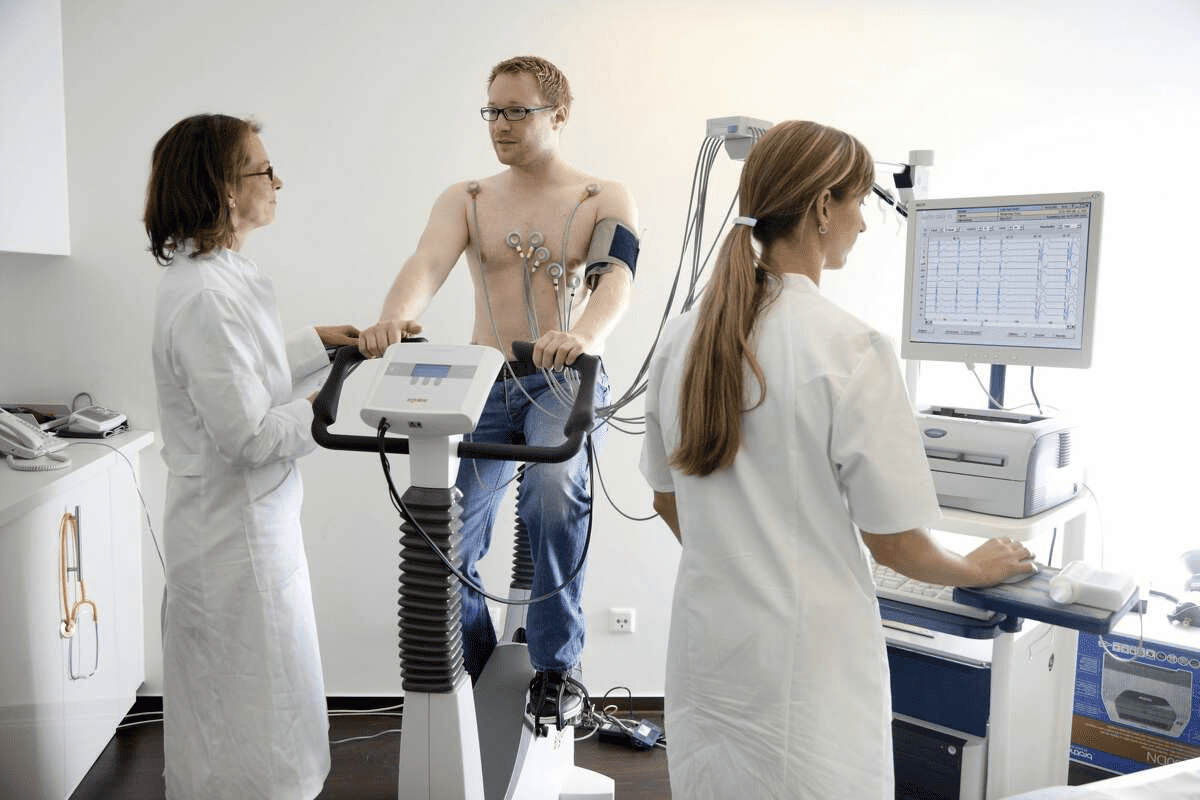Last Updated on November 27, 2025 by Bilal Hasdemir

Finding bone cancer early is key to successful treatment, and at Liv Hospital we place the patient at the center of our care, using the latest tools for quick and accurate results. We use a range of diagnostic methods, including imaging and laboratory tests, to detect suspicious bone changes as soon as possible. If there is a concern about a bone growth being cancerous, we may take a tissue sample for biopsy. Our team relies on advanced tests such as PET scans, MRI, CT scans, blood tests, and X-rays to confirm the diagnosis. Many patients ask, will a PET scan show bone cancer? In most cases, PET scans can detect areas of abnormal metabolic activity in the bones, helping to reveal cancerous growths and assess if the disease has spread. By combining PET scans with other imaging techniques, we ensure the most accurate and timely diagnosis possible for effective treatment planning.
Key Takeaways
- Early detection of bone cancer is key to good treatment.
- Liv Hospital uses a patient-focused approach with the latest tools.
- Many tests, including imaging and lab work, help find bone cancer.
- A biopsy is the only sure way to find bone cancer.
- Tests include PET scans, MRI, CT scans, blood work, and X-rays.
Bone Cancer Basics: Types, Symptoms, and Risk Factors

Understanding bone cancer starts with knowing its types, symptoms, and risk factors. It’s a complex condition that can start in the bones or spread from other parts of the body.
Primary vs. Secondary Bone Cancer
Bone cancer is divided into two types: primary and secondary. Primary bone cancer starts in the bones. Secondary bone cancer comes from other parts of the body, like the breast or lung.
Common Warning Signs and Symptoms
It’s important to know the symptoms of bone cancer early. Common signs include bone pain, swelling, and tenderness. Bone cancer can also make bones weak, leading to fractures.
High-Risk Groups for Bone Cancer
Some groups are more likely to get bone cancer. These include people exposed to radiation, those with genetic conditions, and those who had cancer treatments before.
The Critical Role of Early Detection in Treatment Success

Early diagnosis is key to managing bone cancer well. If caught early, treatments work better, and patients do better, too.
Survival Statistics and Early Diagnosis
Survival rates for bone cancer patients depend a lot on when they’re diagnosed. Studies show that early diagnosis leads to much better survival rates.
- Localized bone cancer: 5-year survival rate is about 70%
- Regional bone cancer: 5-year survival rate is around 40%
- Distant bone cancer: 5-year survival rate is about 30%
These numbers highlight how vital early detection is for better survival chances.
When to Seek Medical Evaluation
Knowing when to see a doctor is important. Look out for signs like persistent bone pain, swelling, or a lump. Don’t ignore these signs.
“If you’re experiencing persistent bone pain or swelling, it’s essential to consult a healthcare professional promptly. Early evaluation can lead to early detection and more effective treatment.”
Medical Expert
Being proactive about your health can greatly improve treatment results.
The Diagnostic Journey: What to Expect
The process of diagnosing bone cancer involves several steps. From initial screening to confirming the diagnosis, knowing what to expect helps patients prepare.
- Initial assessment: Medical history and physical examination
- Imaging tests: X-rays, CT scans, MRI, or PET scans
- Blood tests: To check for certain biomarkers
- Biopsy: To confirm the presence of cancer cells
Each step is important for finding out if you have bone cancer and how far it has spread. It helps doctors decide on the best treatment.
By knowing the diagnostic process and the importance of early detection, patients can take steps to manage bone cancer effectively.
X-Ray Imaging: Initial Screening for Bone Abnormalities
X-ray imaging is key in the first step to find bone cancer and other bone problems. It’s a common and fast test. Doctors use X-rays to spot bone issues that need more evaluation.
How X-Rays Identify Bone Tumors
X-rays use a small amount of radiation to show the inside of the body, like bones. They can spot:
- Abnormal bone growth or destruction
- Changes in bone density
- Fractures or lesions
These signs might mean there’s a bone tumor, good or bad. But X-rays might not tell the whole story about the tumor.
Can a Knee X-Ray Show Cancer?
Yes, a knee X-ray can show cancer signs. For example, it might show:
- An area of bone destruction
- An abnormal growth or mass
- Changes in the bone’s structure
Limitations and Follow-Up Testing
Even though X-rays are helpful at first, they have limits. For example:
- X-rays might miss soft tissue problems.
- They can’t always tell if a tumor is good or bad.
- Some parts, like the spine or pelvis, are hard to see with X-rays alone.
So, if an X-ray finds something, doctors usually suggest more tests. These might include CT Scans, MRI, or a biopsy. They help get a clear diagnosis.
CT Scans for Bone Cancer: Detailed Cross-Sectional Imaging
CT scans are key in finding bone cancer. They give detailed images of the body. This helps doctors see if there’s a tumor and how big it is.
Role of CT Scans in Bone Cancer Detection
CT scans are great for spotting bone cancer. They show the bone and the tissues around it clearly. A study on the National Center for Biotechnology Information says they help find the tumor’s size, where it is, and if it’s spreading.
CT Scan Procedure for Bone Assessment
The CT scan process for checking bones is simple. Patients lie on a table that moves into a CT scanner. The scanner takes X-ray images from different angles. These images are then turned into detailed views of the body.
The steps are:
- Preparation: Patients remove metal objects or jewelry.
- Positioning: The patient gets on the CT table.
- Scanning: The CT scanner takes many X-ray images.
- Image Reconstruction: The images are made into detailed views.
CT Scan Accuracy and Limitations
CT scans are very good at finding bone cancer. But they have some limits. How well a CT scan works can depend on the equipment quality and the radiologist’s skill.
| Diagnostic Tool | Accuracy | Limitations |
| CT Scan | High resolution for bone structures | May not clearly distinguish between tumor types |
| PET Scan | Effective for detecting metabolic activity | Can be less specific for certain tumor types |
| MRI | Excellent for soft tissue assessment | May not be as effective for bone detail |
Knowing what CT scans can and can’t do is key to accurate diagnosis and treatment planning.
Will a PET Scan Show Bone Cancer?
PET scans have changed how we find bone cancer. They show how tumors work, not just where they are. This helps doctors understand tumors better.
Detecting Metabolic Activity in Tumors
PET scans use a special dye to find tumors. This dye goes to cells that are very active, like cancer cells. It helps see if a bone tumor is cancer.
Key aspects of PET scans in bone cancer detection include:
- Identifying metabolically active tumors
- Differentiating between benign and malignant lesions
- Assessing the extent of cancer spread
PET-CT Combination for Enhanced Detection
Using PET and CT scans together, called PET-CT, makes finding tumors better. It shows how tumors work and where they are. This helps doctors find and understand tumors better.
The benefits of PET-CT include:
- Improved diagnostic accuracy
- Better staging of cancer
- Enhanced planning for treatment
Sensitivity and Specificity for Bone Malignancies
PET scans are very good at finding bone cancers. They spot tumors that are active. But how well they work can change based on the dye used and the tumor itself.
Factors influencing the sensitivity and specificity of PET scans include:
- Type of radioactive tracer used
- Tumor biology and metabolic activity
- Technical aspects of the PET scan procedure
PET scans, with CT scans, are a key tool in fighting bone cancer. They give doctors the info they need to make treatment plans.
MRI Technology for Bone Cancer Detection
MRI scans are key in finding bone cancer and seeing how far it has spread. They help doctors plan the best treatment. MRI shows soft tissues and bone marrow in detail, making it a must-have for bone cancer patients.
Can MRI Detect Bone Cancer?
Yes, MRI can find bone cancer. It’s great for seeing how big the tumor is and where it is. MRI is very good at spotting bone cancer in places like the spine and long bones.
MRI is also good because it can tell different tissues apart. This helps doctors know if a tumor is aggressive. Plus, it doesn’t use harmful radiation, so it’s safer for patients who need many scans.
Advantages of MRI for Soft Tissue and Marrow Assessment
MRI has many benefits for checking soft tissues and marrow in bone cancer. It gives clear images that show how far a tumor has spread. This is important for figuring out the cancer’s stage and treatment plan.
- Detailed images of soft tissues and marrow
- Can spot changes in tissue
- No harmful radiation, safe for many scans
- Great for seeing how much a tumor has spread
These benefits make MRI very useful in treating bone cancer. It helps doctors make more accurate diagnoses and plans.
MRI Procedure and Patient Experience
The MRI process for bone cancer usually starts with lying on a table that moves into the scanner. Patients must stay very quiet during the scan to get clear pictures. The whole thing can take from 15 to 90 minutes, depending on the scan’s details.
To get better pictures, contrast agents might be used. These agents make tumors stand out. Some people might feel a bit uncomfortable because of the tight space, but there are open MRI machines for those who are claustrophobic.
In summary, the MRI process is very important for diagnosing and treating bone cancer. It gives doctors the info they need to make treatment plans.
Blood Work for Bone Cancer: Biomarkers and Limitations
Blood tests play a key role in finding bone cancer. They look for biomarkers that show cancer might be there. These tests help doctors check how well patients are doing and spot bone cancer problems.
Does Bone Cancer Show Up in Blood Work?
Blood tests can hint at bone cancer, but it’s not always clear. Some biomarkers in the blood might point to bone cancer. But, these markers can also show up in other health issues.
Doctors look at blood for substances like alkaline phosphatase, LDH, and calcium. High levels of these can mean bone damage or tumors.
Specific Blood Tests Used in Bone Cancer Assessment
Several blood tests help check for bone cancer. These include:
- Complete Blood Count (CBC): To check for anemia, infection, or abnormal blood cell counts.
- Blood Chemistry Tests: To evaluate liver and kidney function, as well as measure levels of certain enzymes and proteins.
- Tumor Marker Tests: Such as alkaline phosphatase and LDH, which can be elevated in bone cancer.
Understanding Your Blood Test Results
It’s important to understand blood test results. Knowing what each marker means is key. Doctors look at these results along with other tests like imaging and biopsies.
Remember, blood tests are just one tool in finding bone cancer. Even if tests show something odd, it doesn’t always mean cancer. And if tests seem normal, it doesn’t mean there’s no cancer. Doctors use all the info they have to make a correct diagnosis.
Bone Biopsy: The Gold Standard for Diagnosis
A bone biopsy is the most accurate test for diagnosing bone cancer. It involves taking a sample of bone tissue for examination. This is key to confirming cancer and its type.
Diagnostic Approaches: Needle vs. Surgical Biopsy
There are two main ways to do a bone biopsy: needle biopsy and surgical biopsy. Needle biopsy uses a thin needle to get a tissue sample. Surgical biopsy makes a bigger cut to remove more tissue or the whole tumor.
The choice depends on the tumor’s size, location, and the patient’s health. Needle biopsy is less invasive, leading to faster recovery. Surgical biopsy is needed for bigger or more complex tumors.
Managing Pain and Recovery
Pain management is key during the biopsy. We use anesthesia to reduce pain during the procedure. After, patients might need pain meds to manage any discomfort.
Recovery time varies by biopsy type. Needle biopsies have a quick recovery, with most people back to normal in days. Surgical biopsies take longer.
Understanding Accuracy and Result Interpretation
Bone biopsies are very accurate, making them a trusted diagnostic tool. The pathologist examines the tissue sample to find cancer cells and identify the cancer type.
It’s important to understand biopsy results for treatment planning. A diagnosis of bone cancer leads to talks about treatment options. Our team helps patients understand their results and plan treatment.
Bone Scan: Nuclear Medicine Approach to Detection
Detecting bone cancer often involves a bone scan, a sophisticated diagnostic technique. It uses nuclear medicine. A bone scan is a sensitive test that helps identify areas of abnormal bone activity. This can be indicative of cancer.
Radiotracer Technology and How It Works
We use radiotracer technology in bone scans to visualize bone metabolism. A small amount of a radioactive material, typically Technetium-99m methylene diphosphonate (Tc-99m MDP), is injected into the bloodstream. This radiotracer accumulates in areas of high bone activity, such as tumors, fractures, or infections.
It makes them detectable by a gamma camera. The radiotracer emits gamma rays. These are then captured by the gamma camera to produce images of the skeleton.
Patient Preparation and Procedure
Preparing for a bone scan is relatively straightforward. Patients are typically required to arrive at the imaging facility about 30 minutes before the scan. The procedure involves:
- Injection of the radiotracer into a vein, usually in the arm.
- Waiting for 2-4 hours to allow the radiotracer to distribute throughout the skeleton.
- During this time, patients can usually resume normal activities but are advised to drink plenty of water to help eliminate the radiotracer from the body.
- Lying on a scanning table while the gamma camera captures images of the skeleton.
Interpreting Bone Scan Results
Interpreting bone scan results requires expertise. The images can reveal various bone conditions. Areas of increased radiotracer uptake, known as “hot spots,” can indicate bone cancer, but also other conditions like fractures or arthritis.
To accurately diagnose bone cancer, doctors consider the bone scan results with other diagnostic tests. This includes X-rays, CT scans, or biopsies. The pattern and intensity of radiotracer uptake can provide valuable clues about the nature of the bone abnormality.
| Condition | Typical Bone Scan Findings | Additional Diagnostic Clues |
| Bone Cancer | Intense, focal uptake in a bone lesion | Destruction of bone architecture on X-ray or CT |
| Fracture | Linear or focal uptake at the fracture site | History of trauma, X-ray confirmation |
| Arthritis | Uptake around joints, often bilateral | Clinical symptoms, X-ray evidence of joint degeneration |
By combining bone scan results with clinical information and other diagnostic findings, healthcare providers can make more accurate diagnoses. They can develop effective treatment plans for patients with suspected bone cancer.
Comparing Effectiveness: Which Test Is Best for Bone Cancer?
Diagnosing bone cancer requires knowing the strengths and weaknesses of different tests. We’ll look at how sensitive and specific each test is, and its costs. This will help us find the best way to diagnose bone cancer.
Sensitivity and Specificity of Each Test
Here’s a quick look at how common bone cancer tests perform:
- PET-CT: High sensitivity for detecting metabolic activity
- MRI: High specificity for soft tissue and marrow assessment
- CT Scan: Detailed cross-sectional imaging with moderate sensitivity
- X-Ray: Initial screening with lower sensitivity for early-stage cancer
Cost and Accessibility Considerations
The cost and availability of tests are key in choosing the right diagnostic path. Cost-effectiveness is very important, as it affects healthcare budgets. While PET-CT scans are very accurate, they are pricier than X-rays or CT scans.
Combining Tests for Accurate Diagnosis
Using more than one test can make diagnosing bone cancer more accurate. For instance, combining PET-CT with MRI gives both metabolic and anatomical details. This multi-modal approach helps tailor the diagnosis to each patient’s needs.
Advanced and Emerging Technologies in Bone Cancer Detection
New technologies are making bone cancer detection more accurate and efficient. These advancements help doctors diagnose better and treat more effectively. They also make treatments more tailored to each patient.
Whole-Body MRI and Diffusion-Weighted Imaging
Whole-body MRI is a key tool for finding bone cancer. It looks at the whole body at once, unlike old methods that focus on one area. This makes it easier to see how far the cancer has spread.
Diffusion-weighted imaging (DWI) works with MRI to spot tumors better. It shows how water moves in tissues, making tumors stand out. This combo helps doctors find cancer more easily.
Artificial Intelligence in Imaging Interpretation
Artificial intelligence (AI) is changing medical imaging, including for bone cancer. AI can look through lots of images fast and find tumors that might be missed. This helps doctors make better diagnoses.
Using AI in imaging makes doctors’ jobs easier. It lets them focus on harder cases and plan treatments that fit each patient’s needs.
Liquid Biopsy and Circulating Tumor DNA
Liquid biopsy is a new way to find cancer without surgery. It checks the blood for tumor DNA. This is great for bone cancer because it can find specific genetic changes.
Liquid biopsy is safer than old biopsies and lets doctors track the cancer’s growth. It’s a big step forward in cancer care.
| Technology | Description | Benefits |
| Whole-Body MRI | Comprehensive body imaging | Detects disease spread, complete check-up |
| Artificial Intelligence | AI-assisted imaging analysis | Better accuracy, easier workflow |
| Liquid Biopsy | Analysis of ctDNA in blood | Safe, tracks cancer growth |
Conclusion: Navigating Your Bone Cancer Diagnosis Journey
Getting a bone cancer diagnosis can be tough. But knowing how doctors test for it helps you make smart choices. We’ve looked at tests like PET, MRI, CT scans, blood work, and X-rays. Each one is key in spotting bone issues and finding cancer.
It’s important to know if blood tests can show bone cancer. Blood tests aren’t the only way to find bone cancer. But they can tell us about biomarkers and your health. To get a clear diagnosis, doctors use many tests together.
To handle your bone cancer diagnosis well, you need to understand the testing process. Working with your doctors and using different tests helps. This way, you get the right diagnosis and treatment plan.
FAQ
Does bone cancer show up in blood work?
Some bone cancers might show up in blood tests, like high alkaline phosphatase levels. But blood tests alone can’t confirm bone cancer. We use many tests together for a sure diagnosis.
Can an MRI detect cancer in the bone?
Yes, MRI is great at finding bone cancer. It shows soft tissue and marrow involvement well. This helps us see how far the disease has spread.
Will a PET scan show bone cancer?
PET scans can spot bone cancer by showing active cancer cells. The PET-CT combo is even better for finding and staging the disease.
Can a CT scan show bone cancer?
Yes, CT scans can show bone cancer with detailed images. But, they might miss some types of bone cancer.
Can a knee X-ray show cancer?
A knee X-ray might find bone tumors or signs of cancer. But X-rays have limits. We often need more tests to be sure.
How do you check for bone cancer?
We use many tests to find bone cancer, like X-rays, CT scans, MRI, PET scans, blood work, and bone biopsy. Each test gives us different information to diagnose and stage the disease.
What is the role of blood tests in bone cancer detection?
Blood tests can hint at bone cancer, like high enzyme levels. But, they’re not enough on their own. We use them with other tests.
How accurate is a bone biopsy in diagnosing bone cancer?
The bone biopsy is very accurate for diagnosing bone cancer. It takes a bone sample for a microscope check.
What are the emerging technologies in bone cancer detection?
New tech includes whole-body MRI, AI in imaging, and liquid biopsy. These are making bone cancer detection better and faster.
Why is early detection of bone cancer important?
Finding bone cancer early is key to better treatment and survival. Knowing how to get checked early can really help.
References
- şukaszewski, B., & Gş‚owacki, M. (2017). Diagnostic methods for the detection of bone metastases. Contemporary Oncology, 21(3), 160“166. https://www.ncbi.nlm.nih.gov/pmc/articles/PMC5611498/






